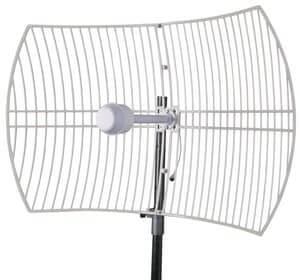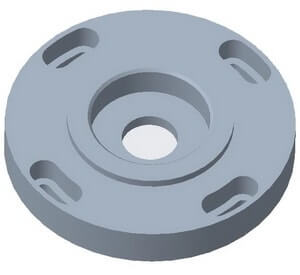A parabolic dish antenna is a directional antenna. The parabolic dish antenna can amplify signals because its shape concentrates the radio waves into a specific focal point. It allows the antenna to achieve a higher gain, or amplification, than other types of antennas.
A high gain directional antenna which is typically used to receive or transmit signals in the wireless backhaul networks at 4.9-6.4GHz, is a WiFi Parabolic Dish Antenna. It can extend the range of a wireless hotspot from 3 miles to 30 miles. However, the parabolic dish antenna can only transmit or receive signals in the infrared and visible light ranges, Light of Sight(LOS).
WiFi Parabolic Dish Antenna Frequency:
2.4GHz: 2400-2484MHz
5.8GHz: 4900-6500MHz
WiFi 7: 5925-7125MHz
The WiFi Parabolic Dish Antenna offers high gain and a wide frequency range, ideal for long-range wireless applications. The parabolic dish antenna is also highly resistant to interference, making it an excellent choice for congested areas. With a WiFi Parabolic Dish Antenna, you can extend the range of your wireless network and get better performance from your hotspot.
Parabolic Dish Antenna Types
#1 Grid Parabolic Dish Antenna
Grid parabolic dish antennas are a type of directional antenna that can transmit and receive radio frequency signals. It’s widely used for SISO radios. It has been abandoned for a long time during the WiFi networks.

A grid parabolic dish antenna is made from parallel metal rods or wires mounted in a grid pattern on a frame. A reflector is then attached to the frame, and this reflector is shaped like a parabola. Although some antennas use a plastic reflector, the frame and reflector are typically made from metal.
The grid pattern of the metal rods or wires helps focus the signal in a specific direction, and the reflector amplifies the signal. These antennas are often used in long-range communications, such as satellite TV and radio, as they can send and receive signals over great distances.
#2 Solid Parabolic Dish Antenna
A parabolic dish antenna is used to direct radio waves. The most common form is the solid dish antenna. A solid Parabolic Dish Antenna uses a solid reflector rather than wire mesh. Solid dish Parabolic Dish Antenna is often used in applications where a high gain or concentrated signal is needed.

The reflector on a solid dish Parabolic Dish Antenna is made of a single piece of metal(aluminum alloy), making it more durable than a wire mesh reflector. It also eliminates the need for a frame, which can add weight and complexity to a dish antenna. Additionally, a solid Parabolic Dish Antenna can be made larger than a wire mesh reflector without leaking signal through gaps. Thus, it makes a good choice for Point-to-Point applications.
Advantages & Disadvantages of Parabolic Dish Antenna
Advantages of Parabolic Dish Antenna:
- Parabolic dish antennas have a narrow beamwidth, allowing for high gain and directionality.
- They are also relatively easy to construct and can be made quite small.
- Parabolic dish antennas are also very efficient at transmitting and receiving signals.
Disadvantages of Parabolic Dish Antenna:
- One of the main disadvantages of parabolic dish antennas is that they require a precise alignment to work correctly.
- They are also quite sensitive to wind and other environmental factors, affecting their performance.
- Additionally, parabolic dish antennas are often quite expensive to purchase and install.
In conclusion, while parabolic dish antennas have several advantages, they also have many disadvantages that should be considered. When deciding whether or not to use a parabolic dish antenna, it is essential to weigh all of the pros and cons to make the best decision for your particular situation.
Parabolic Dish Antenna Accessories and Functions
Reflector
The reflector is the most costly component of a parabolic dish antenna. It is a curved surface that reflects the incoming radio waves and focuses them towards the receiver. The reflector is usually made from aluminum alloy with lightweight for low cost and easy installation. It is usually covered with an outdoor powder coating for long service life.

Waveguide Feedhorn
The feedhorn is the most critical a of a parabolic dish antenna. It’s the key because it can decide the parameters ad performance such as frequency range, gain, isolation, etc.

A feedhorn is used to couple the feedline to the reflector in a parabolic dish antenna. The feedhorn is placed at the reflector’s focal point, and the feed line is connected to it. The feedhorn collects the RF energy from the feedline and focuses it onto the reflector, reflecting the energy in the desired direction. There are many different types of feed horns available on the market, and each has its own set of benefits and drawbacks. Some feedhorns are designed to work with a specific feedline, while others are more versatile and can be used with various feedline types.
Flange
A flange is a flat circular piece of metal connected to the dish reflector. It can attach the feedhorn to a parabolic dish reflector. The flange mount has holes that align with the bolts on the dish antenna. The mount is then attached to a flat surface with screws or bolts.

Flange mounts are used when the antenna’s surface is not perfectly flat. The flange mount will help level the dish antenna and keep it from wobbling.
Mounting Bracket
The mounting bracket is the most crucial accessory for a parabolic dish antenna, and it is what allows the dish to be mounted on a structure, usually a mast or pole on the tower. The type of bracket you need will depend on the specific dish you have, so check with the manufacturer or retailer before purchasing one.

Protection Radome
A protection radome is a typically dome-shaped cover installed over the top of a parabolic dish antenna to protect it from the elements. The protection radome shields the antenna from rain, snow, and hail, as well as from wind-blown debris. It also helps to keep the antenna clean, improving its performance.

The protection radome is a typically durable and robust material, such as fiberglass or polycarbonate. It is vital to ensure that the radome is sealed correctly to the dish to prevent moisture and dirt from getting inside.
WiFi Parabolic Dish Antenna Polarization
A parabolic dish antenna uses a reflector, a cross-sectional shape curved surface of a parabola, which directs the radio waves. The reflector focuses the waves into a small beam, which is then directed at a receiver.
The waves reflected by the dish are in phase, which means that all waves reach the receiver simultaneously and create a stronger signal. That is why parabolic dish antennas are often used for the backhaul communications.
The polarization of a parabolic dish antenna can be either linear or elliptical. Linear polarization means that the waves are all aligned in the same plane, while elliptical polarization means that the waves are aligned in two planes, horizontal or vertical.
Parabolic dish antennas can be either right-handed or left-handed. Right-handed antennas have a clockwise polarization, while left-handed antennas have a counterclockwise polarization.
Some antenna designs use a combination of linear and elliptical polarization, while others use circular polarization. Circular polarization is created when the waves are aligned in a spiral.
This is useful for antennas mounted on moving vehicles, such as aircraft or ships, because it helps to reduce the amount of interference they receive from other sources.
The polarization used for a parabolic dish antenna depends on the application. Sanny Telecom WiFi parabolic dish antennas support both Dual Polarized (horizontal & vertical) and Dual Slant (+45/ -45) polarity.

How To Connect the Parabolic Dish Antenna to the Radio/ AP(Access Point)?
There are various connection types based on the applications and the radio interface.

A low loss coax cable assembly(pigtail) is widely used for WiFi networks. It can connect the parabolic dish antenna to radio such as Cambium Networks, Mikrotik, Radwin, Ubiquiti, etc.
Pigtail Connector
N-Type: This connector is used for coaxial cables with a diameter of about 3.5mm. It has a threaded N-type plug on one end and an N-type socket on the other

SMA Type: This is a smaller version of the N-type connector used for coaxial cables with a diameter of about 2.4mm. It has a threaded SMA plug on one end and an SMA socket on the other.

Pigtail Coax Cable
195 (3D-FB) Series: This coaxial cable series is a low loss for high-frequency applications up to 6.5 GHz. It has a foam PE dielectric with a jacket diameter of 4.80mm and a solid copper core with a diameter of 1.02mmm.
240 (5D-FB) Series: This series of coaxial cables is low loss for high-frequency applications up to 18 GHz. It has a foam PE dielectric with a jacket diameter of 7.50mm and a CCA core with a diameter of 1.80mm.
400 (7D-FB)Series: This coaxial cable series is low loss for high-frequency applications up to 26.5 GHz. It has a foam PE dielectric with a jacket diameter of 10.16mm and a CCA core with a diameter of 2.74mm.


